Post Independence History- I | History Optional for UPSC PDF Download
INDIA AND HER NEIGHBOURS (1947–1964)
INDIA AND PAKISTAN
On 27″ August regular Pakistani troops crossed the Cease — Fire Line (CFL) but retired after a heavy clash with Indian forces.
- In September 1965, Pakistan initiated a significant offensive against India. The United Nations Security Council addressed the issue, passing a resolution that demanded both countries to halt all hostile activities. Consequently, a cease-fire was declared on September 23rd, with both Indian and Pakistani armies maintaining their positions at the time. However, despite the presence of military observers from neutral countries, Pakistan continued to commit minor infractions, leading India to file a strong protest.
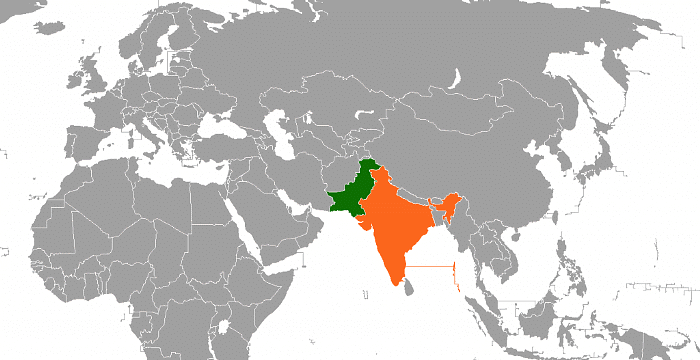
- To reestablish friendly relations between the nations, the Soviet Union's Prime Minister, Mr. Kosygin, organized a meeting between the Indian Prime Minister and the Pakistani President. This meeting took place in Tashkent, in Russian Turkistan, in January 1966. Both parties signed an agreement for peace and friendship. Tragically, Indian Prime Minister Lal Bahadur Shastri passed away suddenly on January 11th, 1966, shortly after the agreement was signed.
INDIA AND CH1NA
- On 25″ October 1950, China suddenly invaded Tibbet and forced her ruler Dalai Lama to sign a treaty by which the autonomy of Tibbet was replaced by the full-fledged sovereignty of China. The Indian government opposed it. this.
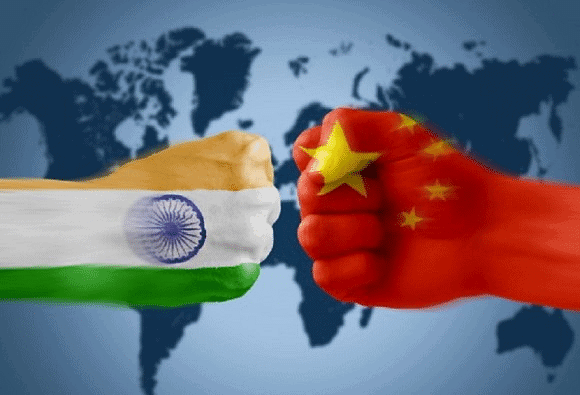
- The Tibbet issue proved to be a major irritant in Indo-China relations. Tibet was an autonomous region within China at the time of Indian independence. During British rule, India enjoyed some rights and special privileges in Tibbet like an agent in Lhasa, trade agencies in Gyantse and Yantung, post & telegraph offices on the trade route to Gyantse, and a small military escort for their protection. Independent India inherited these privileges.
- The Panchasheel agreement was signed between India and China (By P.M. Nehru and Chau en Lai) on 20″ April 1954 at Delhi.
- The Principles of Panchasheel
The five principles of the Panchsheel are:
(a) Mutual respect’s territorial integrity and sovereignty
(b) Non — Aggression
(c) Non — interference in each other’s internal affairs
(d) Equality and mutual benefit
(e) Peaceful co-existence
Linguistic Reorganization of States
- In 1917, the Congress Party had committed itself to the creation of linguistic provinces in a Free India.
- After Congress’s Nagpur Session in 1920, the principle was extended and formalized with the creation of provincial Congress Committee by linguistic zones.
- The linguistic reorganization of the Congress was encouraged and supported by Mahatma Gandhi.
First Linguistic Province commission (LPC)
- The First Linguistic Province Commission (LPC) was established due to the increasing demand for the reorganization of Indian states on a linguistic basis, particularly from regional Congress communities. This followed the bitter partition of the country on religious grounds, which had made Prime Minister Nehru concerned about further divisions based on language.
- In 1948, the Constituent Assembly appointed the Linguistic Provinces Commission, led by Justice SK Dhar, to investigate the feasibility and desirability of creating linguistic provinces. However, the Dhar Commission recommended against this idea at the time, citing concerns that it could threaten national unity and pose administrative challenges.
- Instead, the LPC under Dhar's leadership favored reorganizing states based on administrative convenience rather than linguistic criteria.
Second Linguistic Province commission (LPC)
- In Dec, 1948 a second LPC was formed to again verify the report given by Dhar & look into the matter again.
- Members → J.L. Nehru, Vallabh Bhai Patel & Pattabhi sitaramayya
- They gave the same report as given by Dhar, hence on 26th Jan, 1950 division took place as –
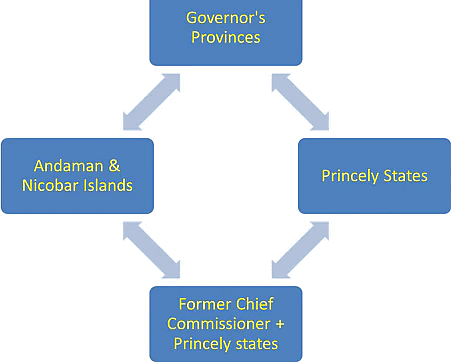
Formation of 1st linguistic State
- Following India's independence, Telugu speakers urged the Congress to implement its previous resolution supporting the creation of linguistic states. They employed various methods to promote their cause, such as petitions, representations, street marches, and protests.
- Potti Sriramulu, a well-known freedom fighter, went on a hunger strike to demand the establishment of a separate Andhra state. After not eating for fifty-eight days, he tragically passed away. His death sparked widespread public outrage, leading to riots, demonstrations, hartals, and violence throughout the Andhra region.
- The Vishal-andhra movement, which aimed to unite all Telugu-speaking regions, became increasingly violent. Eventually, in 1952, Prime Minister Nehru announced the formation of a separate state to address the escalating tensions. This decision led to the establishment of Andhra Pradesh, the first linguistic state in India.
States Reorganization Commission 1953
- The formation of Andhra Pradesh spurred the struggle for making of other states on linguistic lines in other parts of the country.
- Hence Nehru appointed states Reorganisation Commission with Justice Fazl Ali, KM Panikkar & H Kunzru as members, to examine the entire question of the reorganization of the states of the Union. They recommended –
- Abolition of 4 fold classification of states
- Recommended creation of 16 states & 3 centrally administered territories
States Reorganization Act: 1956
- It provided for fourteen states and six centrally administered territories.
- SRC opposed the splitting of Bombay & Punjab.
Formation of States till 2014
An opening was through to make more states in India as per the needs of the situation, but only after the decision of parliament. This led to formation of a number of new states in India as shown below:
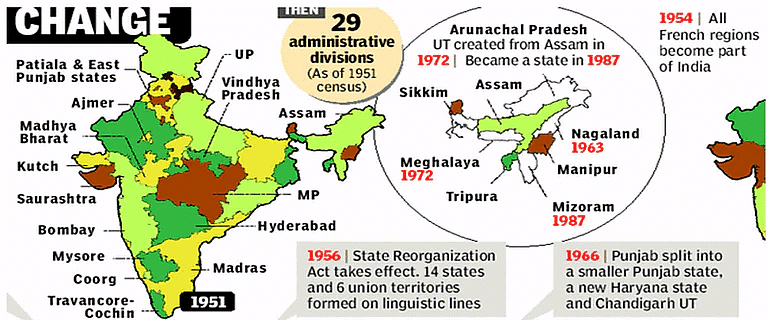
- Bombay reorganization act, 1960 : Formation of Gujrat
- State of Nagaland act, 1962 : Nagaland as separated state from Assam
- Punjab reorganization act, 1966 : Formation of Haryana
- New state of Himachal Pradesh act , 1970
- North eastern reorganization act, 1971 : Formation of Manipur, Tripura, Meghalaya, Mizoram & Union territories of Arunachal Pradesh & Mizoram
- New state of Sikkim act , 1975
- State of Arunachal Pradesh Act, State of Mizoram act 1986 : Formation of States of Mizoram & Ar. Pradesh
- State of Goa Act, 1987
- P reorganization act, 2000 : Formation of Chhattisgarh
- P reorganization act, 2000 : Formation of Uttarakhand
- Bihar reorganization act, 2000 : Formation of Jharkhand
- Andhra Pradesh reorganization act, 2014 : Formation of Telangana
Pending demands for new states in India
Formation of Telangana created a flame among other separatist movement for creation of new states. There are still long pending demands for state formation on the different basis viz. ethnicity, lack of development, administrative inconvenience.
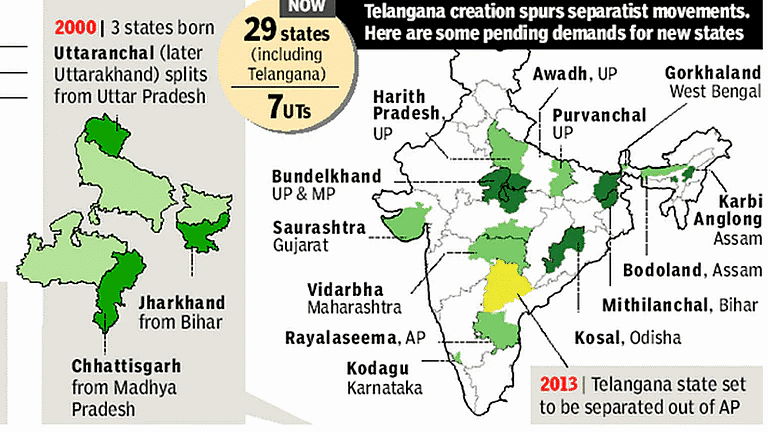
Regionalism
Basis of Regionalism
Local patriotism and loyalty to a locality or region or state and its language and culture do not constitute regionalism nor are they disruptive of the national unity. Aspiring to or making special efforts to develop one’s state, to remove poverty, implementing social justice is not branded as regionalism. However, if any state asserting its pride & interests above the national interest and against the nation in a hostile manner, then that can be dubbed as regionalism
- The linguistic reorganization of India & the resolution of the official language controversy have played an important role by eliminating a patent cause of the feeling of cultural loss or cultural domination.
- Despite such amity & peace, there exist many regional disputes which create friction between regional states like on sharing of river waters
Integration of Princely States
Integrating post-partition India and the princely states under one administration was a crucial task faced by the political leadership at the time. Approximately 40% of the territory in colonial India was occupied by 565 princely states, ruled by princes with varying degrees of autonomy under the British Paramountcy system.
- Many of these princely states started to dream of their own independent states after India gained independence. Using masterful diplomacy and a combination of persuasion and pressure, Patel integrated hundreds of these princely states. Most of them joined the Constituent Assembly willingly, but others, like Junagarh, Kashmir, Manipur, and Hyderabad, announced their desire to remain independent.
- Junagarh, a small coastal state in Saurashtra, had no connection to Pakistan, yet the Nawab announced accession to Pakistan. However, the majority of the population (mainly Hindus) wanted to join India. This led to a violent movement against the Nawab and Indian troops marching into the state. A plebiscite was held, which favored joining India.
- Kashmir, ruled by the Hindu ruler Hari Singh, tried to negotiate with India and Pakistan to maintain an independent status. As the majority population was Muslim, Pakistan believed that Kashmir should belong to them. Hari Singh offered a standstill agreement allowing for the free movement of people and goods. Pakistan signed the agreement, but India did not. Pakistan became impatient and started violating the agreement, leading to Hari Singh seeking military assistance from India. Mountbatten pointed out that under international law, India could only send troops after the state signed a formal instrument of accession. The Maharaja signed the instrument on October 26th, and Indian troops were sent to Srinagar on October 27th. Pakistan still occupies a large part of the region, known as Pakistan-occupied Kashmir.
- Hyderabad, the largest princely state in India, was ruled by the Nizam. He aspired to establish a Muslim dominion instead of integrating with India and sought an independent status for Hyderabad through a standstill agreement. The people revolted against his rule, particularly the peasants of Telangana, due to his oppressive measures. The Nizam mobilized 150,000 soldiers to fight against the Indian Union, causing much violence and destruction. In September 1948, the Indian army invaded Hyderabad under Operation Polo, overthrew the Nizam, and annexed the state to the Indian Union.
- Manipur's Maharaja signed the instrument of Accession with the Indian government, ensuring that the internal autonomy of Manipur would be maintained. Under public pressure, the Maharaja held elections in June 1948, making Manipur a constitutional monarchy and the first part of India to hold an election based on universal adult franchise. However, the Indian government pressured the Maharaja into signing a Merger Agreement in September 1949 without consulting the elected Legislative Assembly, causing anger and resentment in Manipur that is still felt today.
- In exchange for surrendering their power and authority, the rulers of major states were granted privy purses guaranteed by the constitution, and were allowed to retain certain privileges such as keeping their titles, flying their personal flags, and enjoying gun salutes on ceremonial occasions.
French & Portuguese Territories
- After integration of princely states two trouble spots were French settlement and Portuguese settlements.
- After prolonged negotiation Pondicherry and other French possessions were handed over to India in 1954.
- Portuguese were not ready to handover their areas.
- Their NATO allies supported Portugal’s position and India supported peaceful means.
- In 1961 a people movement demanded support; Indian troops marched in Goa under Operation Vijay & Portuguese surrendered without any fight.
Official Language Resolution Passed - [January 18, 1968]
On 18 January 1968, the Official Language Resolution was passed by both Houses of Parliament. This Resolution was passed to build a comprehensive program to increase the use of Hindu language for official purposes by the Union of India. In this article, you can read about the Official Language Resolution and its implications on India.
What is the Official Language Resolution?
- As per Article 343(1) of the Constitution of India, Hindi in Devanagari script shall be the official language of the Union.
- Article 343(2) provided that English shall also be continued to be used in official work of the Union for a period of 15 years from the date of commencement of the constitution, i.e., up to the 25th of January 1965.
- Again, article 343(3) made provisions for the continuation of English even after 25th January 1965 by empowering the parliament to make laws to that effect.
- Accordingly, the Official Languages Act, 1963 was passed which provided for the continued use of English even after the said date in 1965.
- As per the Act, both English and Hindi shall be used for certain specified purposes like resolutions, rules, general orders, notifications, press communiqués, administrative and other reports, licenses, tenders, etc.
- The government of India has many measures and policies with regard to the promotion of Hindi all over the country as the medium of expression in official work, and this is done in accordance with the various laws and statutory provisions which are: Official Languages Act, 1963; Official Language Resolution, 1968; Official Languages Rules, 1976; Orders of the President on the recommendations of Parliamentary Committee on Official Language; and the general targets and guidelines in the annual programme of the Department of Official Language. The Department of Official Language was formed in June 1975.
Official Language Resolution
As per the Official Language Resolution of 1968, the government shall adopt a more comprehensive programme to accelerate the spread of Hindi for official use by the Union. The resolution also says that an annual measure of progress achieved in this regard will be tabled on both Houses of Parliament, and the same shall be sent to all the State governments as well.
- The Official Language Resolution of 1968 outlines a comprehensive program to accelerate the adoption of Hindi for official use by the Union, with an annual progress report to be presented to both houses of Parliament and shared with all state governments. The resolution emphasizes the promotion of the 14 major languages listed in the eighth schedule of the constitution (currently comprising 22 languages) and the implementation of the three-language formula nationwide. This formula ensures the study of Hindi, English, and another modern Indian language in Hindi-speaking regions, and Hindi, English, and the regional language in non-Hindi speaking states. Candidates for various central government posts must have knowledge of either Hindi or English, with some exceptions where both languages are required.
- The resolution further stipulates that all languages in the eighth schedule can be used as alternative media for all India central services examinations. Various government schemes are in place to promote Hindi, including the Hindi Training Scheme, which provides training in Hindi language, stenography, and typing; the Rajbhasha Gaurav Puraskar Yojana, which encourages book-writing in Hindi, particularly in modern knowledge and science; and the Rajbhasa Kirti Puraskar, which recognizes outstanding promotional work of Hindi as the official language by ministries, departments, PSUs, and banks.
- The Kendriya Hindi Samiti, established in 1967 and chaired by the Prime Minister, is the apex policy-making body that develops guidelines for propagating Hindi as the official language. In addition, the Committee of Parliament on Official Language was formed in 1976 to review the progress made in using Hindi officially. The Department of Official Language publishes a quarterly magazine, "Rajbhasha Bharati," dedicated to promoting Hindi writing in technology, information, literature, and other fields.
Indian states are classified into three regions based on the prevalence of Hindi:
- Region A: Bihar, Haryana, Madhya Pradesh, Himachal Pradesh, Uttar Pradesh, Rajasthan, Delhi, Andaman & Nicobar Islands
- Region B: Maharashtra, Gujarat, Punjab, and the union territory of Chandigarh
- Region C: All other states and union territories not mentioned above.
Conclusion
In conclusion, the years between 1947 and 1964 saw significant developments in India's relations with its neighbors, particularly Pakistan and China, as well as the linguistic reorganization of states within the country. The establishment of the Panchsheel agreement aimed to foster peaceful coexistence and mutual respect between India and China. The integration of princely states and the resolution of official language issues further contributed to India's emerging national identity. The Official Language Resolution of 1968 was a crucial step in promoting the use of Hindi as the official language of the Union, while also encouraging the development of other regional languages. Overall, these events played a critical role in shaping India's political landscape and fostering unity among its diverse population.
Frequently Asked Questions (FAQs) of Post Independence History- I
What was the main reason for the linguistic reorganization of Indian states?
The main reason for the linguistic reorganization of Indian states was to create administrative units based on a common language, which would promote unity and ease communication within the states.
What were the five principles of the Panchsheel agreement between India and China?
The five principles of the Panchsheel agreement were: mutual respect for each other's territorial integrity and sovereignty, non-aggression, non-interference in each other's internal affairs, equality and mutual benefit, and peaceful co-existence.
What was the first linguistic state created in India?
The first linguistic state created in India was Andhra Pradesh, following a movement led by freedom fighter Potti Sriramulu, who went on a hunger strike demanding the establishment of a separate Andhra state.
How did India integrate the princely states after gaining independence?
India integrated the princely states using a combination of diplomacy, persuasion, and pressure. Most of the princely states willingly joined the Constituent Assembly, while others, like Junagarh, Kashmir, Manipur, and Hyderabad, required additional negotiation or military intervention.
What is the Official Language Resolution passed in 1968?
The Official Language Resolution, passed in 1968, aimed to build a comprehensive program to increase the use of Hindi as the official language for the Union of India. It also encouraged the implementation of the three-language formula, where Hindi, English, and a regional language would be taught in schools across the country.
|
367 videos|995 docs
|




















